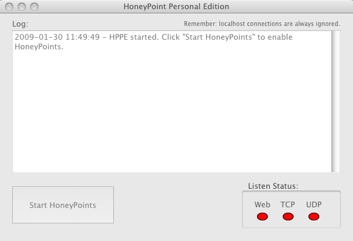MSI is very proud to announce the release of HoneyPoint Personal Edition 2.00!
This update to the favorite product of many users, comes with all kinds of new power and flexibility, plus a greatly simplified and user friendly interface. Plus, it now supports Linux and Mac OS X in addition to Windows.
If you are new to the functions and capabilities of HoneyPoint Personal Edition, it basically serves up “fake” services on systems. These services then lie in wait for attackers and malware to probe them. When someone, or something, does interact with the service, all transactions are recorded, including their source IP address and timeline. Users are then alerted to the activity and can take defensive actions as needed. For more insight into how HPPE works, download the PDF we have designed for the product from here.
The new version includes many new features, including:
HornetPoints to leverage “defensive fuzzing” as an automated form of defense against hacker tools and malware
Plugins (just like HoneyPoint Security Server) to automate responses and allow user-designed/custom alerts, etc.
You can download the product from the link above for FREE and give it a try, then purchase a license when you are ready from the online store. Per seat licenses start at only $29.95!
Users with valid licenses of HPPE 1.XX can upgrade to the newest version and receive a new license key for the special upgrade price of $9.95 per seat by using the checkout coupon code “upgrade351” in the Digital River software store on the bottom of the page linked above.
Check out HoneyPoint Personal Edition for insight into just how fake applications can increase your security and help your users make better security decisions. If you would like a more enterprise-centric version or capability, we offer that and much more through HoneyPoint Security Server. Give us a call or drop us a line to learn more about it anytime.

